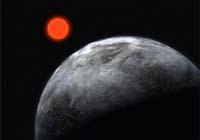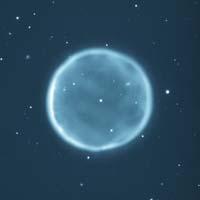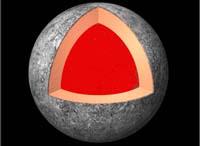Ranking of exoplanets: the most similar to Earth, the hottest, the heavier...

A planet that resembles Earth and behind its star Gliese 581c.
(Picture: ANDÉN)
This planet, which looks like the Earth, had a huge impact on the media. Orbit around the star Gliese 581c, quite close to the Solar System (found at 20.5 light-years) and, according to the first studies, it seems that it can have adequate conditions for life. For example, from the distance from the star it is deduced that on the surface of the planet are between 0-40ºC, so that water, in case of existence, would be in liquid state, which constitutes one of the main living conditions.
It is still very soon to know anything. To have more data, astronomers must observe the planet as it passes in front of its star. This will allow us to know if the planet is rocky, reinforcing the hypothesis that it is similar to Earth. The problem is that the possibility of seeing the planet pass in front of its star is very small, only 2%.
The hottest and heaviest

A nebula in the constellation of Hercules called Abell 39. In this constellation they have found the hottest and most massive planet.
(Photo: NOAO)
The hottest Exoplanet has also been presented. In fact, there will be planets warmer than that, but to that have measured the highest temperature: It has 2,050 °C, that is, almost like a small star. To obtain this data, they have used the NASA's Spitzer space telescope, with which they have studied the infrared radiation emitted by the planet when passing by and behind its star, and have discovered that it is the hottest of the calors.
The planet is called HD 149026b and was discovered in 2005. Of saturn size, it is found in the constellation of Hercules, 256 light-years from Earth. It was said then that its mass is 90 times greater than that of the Earth, that is, its quantity of heavy elements can be greater than that of the whole solar system. Now, along with the communication that is the warmest, they say that it is also the blackest. It seems to absorb all the light emitted by the stars and, instead of reflecting the light, emits the infrared. Like small stars, it can be due to its atmosphere of titanium oxide.
However, it is not the most massive planet. This honor has another of those found in the same constellation, the HAT-P-2b. It is somewhat greater than Jupiter, but its mass is eight times greater. This is not the only feature that surprises astronomers. It is rare that there is so much mass and also has a very elliptical orbit, very close to its star. All this seems strange to them.
Standard and soft

Among so many special planets, a very normal one has been detected. It is called HD 189733b and does not pay attention. It's big, it's close to its weak star, and it's easy to access your data. That is why it is very valuable to astronomers.
And it is that, although in principle they do not seem very attractive, simple exoplanets are necessary. In this way, planets with difficult data collection can be compared to standards and draw conclusions from it.
However, it is not easy to say what a normal planet is. In fact, the planets of the Solar System are also special, depending on where you look. For example, astronomers have recently shown that Mercury, the small planet next to the Sun, contradicts what they thought so far, has a liquid nucleus. Undoubtedly, there are all kinds of planets, even of soft heart.
Published in 7K.
Buletina
Bidali zure helbide elektronikoa eta jaso asteroko buletina zure sarrera-ontzian











